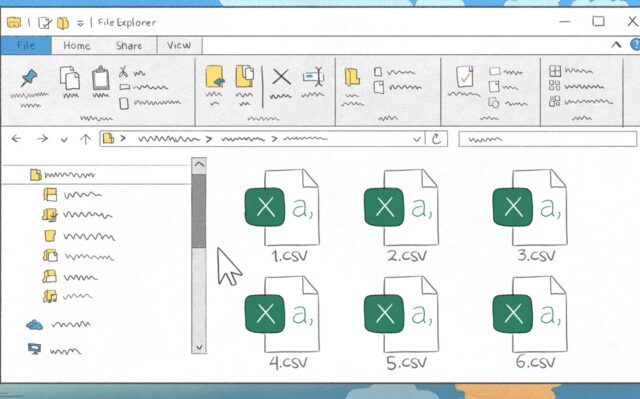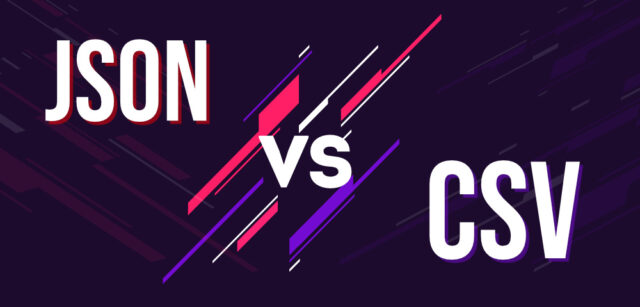
Today pretty much everyone is storing at least some data. We all have information recorded in one form or another on our phones and personal computers. The same goes for businesses, only the amount of data companies store is usually much greater. This leads to a necessity to store data in the most efficient ways. Thus, choosing the right kind of data storing format for particular types of data is now very important. Let us look at the choice between two such data storage formats – JSON vs CSV (read more), to determine which and when should be used.
Choosing the right format
The choice of the format in which the data is recorded can make a big difference for enterprises storing large amounts of information. Every piece of data can be put down in various symbols and structured differently. But not all choices suit every kind of data the same.
We can think about storing data by analogy to packing for a very long trip. Some people manage to pack and carry much more stuff than others, even though they use up the same space. What is their secret? Of course, it is knowing where to put what.
The same is the case with data. Considering JSON vs. CSV is really a consideration between two differently structured ways to use memory space. Let us look at them separately, to see how each of them arranges the items of data in that space.

The power of JSON
JSON stands for JavaScript Object Notation, referring to the JavaScript programming language, from which it was derived. This, however, does not obstruct other widely used programming languages in generating JSON format.
JSON stores information in text format, structures by various syntax elements, including commas, colons, brackets, and many more. This versatile syntax is among the main advantages of JSON. It gives the format power to store various types of data without losing information and protecting the hierarchy of elements.
An important advantage of JSON over other formats with powerful syntax is its user-friendliness. Being derived from a common programming language, JSON is easy to use and master. This makes it a very accessible format that can be used for storing and exchanging more layered types of data.
Furthermore, JSON is very scalable. This means that new data units can be added to the data stored in this format and it will most likely handle it correctly. Due to its versatility, JSON is capable of managing the added data without losing information or damaging the structure of the entire dataset.

The economic CSV
Comma-separated values, or CSV for short, is also a very common data storage format. As the name indicates, CSV stores data in text form with data units separated by commas. Although, due to different systems of noting decimal numbers, semicolons may also be used in CSV instead of commas.
However, in all cases, the syntax of CSV is rather simple and limited. Yet, this limitation is not necessarily a big disadvantage. CSV works great for tabular data, as it is capable of handling it without using any additional unnecessary syntax elements.
The important advantage of CSV is its economic character in relation to memory space. Being compact and simple, CSV manages to save more storage space than pretty much any other data storage format. Thus, provided that CSV’s plain syntax is enough for the data that needs to be stored, it is the best option to record it as it allows more data to be stored within the same memory space.
In addition, as CSV files are plain text, they are easy to create and handle. CSV files can be imported with no difficulty into various databases and using all kinds of software. This flexibility of CSV makes it even more agreeable for usage.

JSON and CSV Data Types
Ultimately, it is easy to see major differences and similarities between the two formats upon closer examination of their structure. For example, JSON utilizes many data types and allows for customization due to its nesting features. On the other hand, CSV is great for tabular data storage because it is limited to numerical and textual data types. It is important to note, CSV can handle other data types, however the formatting permits errors and readability is quite difficult in comparison to other storage formats.
JSON data:
JSON data contains strings, numbers, booleans, nulls, arrays, and objects. JSON gets its name from its primary use of objects to represent values that are key-value pairs. Objects are particularly useful, in that you assign data a key and a value in which the value can be any of the previously mentioned data types (nulls, numbers, booleans, arrays, etc.)
CSV files:
CSV files consist of numerical and textual data placed in columns and rows all separated by commas. The first line of CSV text is typically a header that contains the values that will be used in the file. The remaining rows contain only numbers or text, separated by commas or semicolons that show which column (field) the data entry corresponds to.

JSON vs. CSV: And the winner is… you
So, if we were to decide the winner in the battle of JSON vs. CSV, which one would it be? The answer is twofold.
Firstly, it depends on what type of data we are talking about. If it is more complicated, hierarchical data, it probably needs the higher versatility and power of JSON to be handled. But if it is a simple kind of data, for example, tabular data, the economic features of CSV allow it to do more with less, saving the memory space. Thus, the winner depends on what type of data we need to store.
And secondly, the JSON vs. CSV controversy winner, at the end of the day is the user. Provided that you choose the right type of storing format for the right type of data, you win by getting the most out of the available options for data handling.
Therefore, what matters most is to know your data and choose accordingly.









